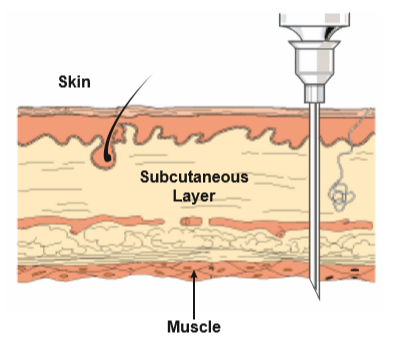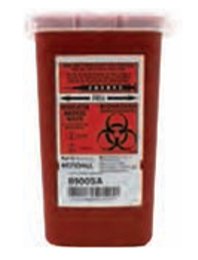| Instructions |
What items do I need to give a shot?
- One alcohol wipe.
- Vial containing the injectable medication.
- The correct size needle and syringe (included in your package)
- You may want to use gloves for your protection or the protection of the person getting the shot.
Syringe Education
- 1cc Insulin syringe (displays units): Each line on the barrel of an insulin syringe is equal to 10 units of HCG once the medication is mixed. So, if your Doctor orders 100 units of HCG, you will draw enough medication to fill the syringe to the ‘10’ line.
- 1ml Leur lock syringe (displays fractioned mL/cc): each line on the barrel an insulin syringe is equal to 10 units of HCG once the medication is mixed. So, if your Doctor orders 100 units of HCG, you will draw enough medication to fill the syringe to the ‘0.1’ line.
- Larger syringes are not recommended for HCG administration.
How to draw up the medication
- Use an alcohol wipe to cleanse the rubber stopper.
- With a fresh, unused syringe, pull back on the plunger to the amount you are injecting, bringing air into the syringe. Your Doctor will decide the dose and frequency that you will be using HCG which will be provided in these instructions.
- Now, remove the plastic cap from the needle. Insert the needle into the vial and slowly push (inject) the air from the syringe into the vial. This will displace the liquid in the vial when you withdraw the medication.
- Turn the vial and syringe upside down and carefully draw the fluid back into the syringe to the line designating the desired amount of medication. If you see any air bubbles, lightly tap or flick the syringe to draw the bubbles to the top (the end with the needle) and expel the air. Note that a small amount of medication may release as well. This is normal. You are now ready to inject.
Subcutaneous Injections
Subcutaneous shots can be given straight in at a 90-degree angle, or at a 45-degree angle. You can give the shot at a 90-degree angle if 2 inches of skin can be grasped between your thumb and first (index) finger. If only 1 inch of skin can be grasped, give the shot at a 45-degree angle
Where can I give a subcutaneous shot?
There are many sites on the body that are safe to give Subcutaneous shots.
- Upper Arm: Uncover the arm to the shoulder to see the whole arm. Have the person getting the shot stand with hand on hip. Stand next to and a little behind the person. Find the area in the middle part of the arm, halfway between the elbow and shoulder. Gently grasp the skin at the back of the arm between your thumb and first 2 fingers. You should have 1-2 inches of skin.
- Abdomen: Uncover the abdomen to see the whole area. Find the waist area. You may give a shot bounded by these landmarks: below the waist, to just above the hip bone, and from where the body curves at the side to about 2 inches from the middle of the abdomen. Use the natural line in the middle of the body as a marker. It may be hard to see, but it is there unless it was covered by surgery. Avoid the surrounding area 2 inches from the bellybutton.
- Thigh: Uncover the entire leg. Find the area between the knee and hip. The middle of the thigh, from mid-front to mid-side, on the outside part of the thigh is a safe site. Gently grasp the area to make sure you can pinch 1-2 inches of skin.

How do I inject medication into subcutaneous tissue?
- Wash your hands thoroughly with soap and dry them completely.
- Open the foil containing the alcohol wipe.
- Using the alcohol wipe, wipe the area where you plan to give the shot. Let the area dry.
- Take the cover off the needle by holding the syringe with your writing hand and pulling on the cover with your other hand. It is like taking a cap off a pen.
- If you will give the shot at a 45-degree angle, hold the syringe in your writing hand. Place the syringe between your thumb and your index second fingers. The needle should be pointing upwards or downwards at the 45-degree angle you plan to use.
- If you will give the shot at a 90-degree angle, hold the syringe with your writing hand. Hold the syringe under your thumb and first finger. Let the barrel of the syringe rest on your second finger. (Many people hold a pen this way when they write.)
- Grasp the skin with the hand not holding the syringe. Holding the syringe barrel tightly with your writing hand, use your wrist to insert the needle through the skin. Sometimes the needle goes in easily. Some people have tougher skin and a little more pressure or quickness is required.
- Once the needle is all the way in, push the plunger down slowly to inject the syringe’s contents.
- Remove the needle at the same angle it went in.
- Dispose of the syringe and needle in a sharps container.

Intramuscular Injections
How to transfer contents from vial to syringe
First, remove the plastic cap from the medication vial and use an alcohol wipe to cleanse the rubber stopper. With a fresh, unused syringe, pull back on the plunger to the amount you are injecting, bringing air into the syringe. Now, remove the plastic cap from the needle. Insert the needle into the vial and slowly push (inject) the air from the syringe into the vial. This will displace the liquid in the vial when you withdraw the medication. Turn the vial and syringe upside down and carefully draw the fluid back into the syringe to the line designating the desired amount of medication. If you see any air bubbles, lightly tap or flick the syringe to draw the bubbles to the top (the end with the needle) and expel the air. Note that a small amount of medication may release as well. This is normal. You are now ready to inject.
Where can I give an intramuscular shot?
The skin and the muscles under the skin cover nerves, blood vessels and bones. It is important to give a shot where you will not hurt any of these body parts. There are 6 possible areas, 3 on each side of the body, where an Intramuscular (IM) shot can be given. It is important to choose the correct area. If caregivers showed you what areas are safe, follow their directions. Constantly change the area where you give shots. If you give a shot in the same place every day or even every week, scar tissue can build up. The scar tissue can negatively affect how the medication will work. Following this information will help you choose the safest areas to give an intramuscular injection.

How do I choose the best muscle for the shot?
If your caregivers have told you which muscle to use, follow their directions. Many change with age. For example, the rear-end area is never used for infants or children under 3-years old because it is not developed well enough. The deltoid may work well for a person with developed muscles in the upper body. The deltoid cannot be used if that area is very thin or underused. The muscle must be easy to reach.
How do I inject nutrients into a muscle?
- Wash your hands thoroughly with soap and dry them completely.
- Put on gloves if necessary. Take the cover off the needle by holding the syringe with your writing hand and pulling on the cover with your other hand. It is like taking a cap off a pen.
- Hold the syringe in the hand you use to write. Place the syringe under your thumb and first finger. Let the barrel of the syringe rest on your second finger. (Many people hold a pen this way when they write.)
- Wipe the area where the needle will go with an alcohol wipe. Let the area dry.
- Depress and pull the skin taut with your free hand. Keep holding the skin a little to the side of where you plan to insert the needle.
- Use your wrist to inject the needle at a 90-degree angle (straight in). The action is like shooting a dart. Do not slowly push the needle in. Do not thrust the needle in, either. Thrusting the needle can cause bruising. The needle is sharp and will go through the skin easily when your wrist action is correct.
- Let go of the skin. As you let go of the skin, hold the syringe so it stays pointed straight in. Pull back on the plunger just a little to make sure you aren’t in a blood vessel. Note: If blood comes back you are likely in a blood vessel. Remove the needle and dispose of both the syringe and the medicine. Repeat the above steps to draw more medicine in a new syringe. When you give the second shot give it on the opposite side.
- Push down on the plunger to inject the medication. Do not force the medication by pushing hard on the plunger. Some medications may sting slightly. They will hurt more if the medication is injected too rapidly.
- Once all the medication is injected, pull the needle out quickly at the same angle it went in.
- Dispose of the syringe and needle in a sharps container.

How do I dispose of used syringes and needles?
You can purchase a Sharps Container, a hard-plastic container made for used syringes and needles, at your local pharmacy. If you did not purchase this container with your medication, you can use a hard-plastic container with a screw-on top such as a clothing softener or hard plastic detergent bottle. Be sure you can put both the syringe and the needle into the container easily. Whatever container you choose, be sure needles cannot break through the sides, bottom or top. Call your primary care physician or your local pharmacy to find out what your state or local requirements are for disposing of used syringes and needles.

Storage
Once mixed, keep HCG in the refrigerator. Prior to being mixed, HCG can be kept at room temperature although it is good habit to store unmixed HCG in the refrigerator. If HCG is left out of the fridge after being mixed it will not damage the medication. Try not to keep it unrefrigerated for more than 72 hours after being mixed. You may continue to use this refrigerated mixture for up to 60 days
Videos
Paste the link in your browser to view >>>>>https://www.youtube.com/watch?v=6DxY21RBX8Q
H ow to inject IM and SC videoPaste the link into your browser to view >>>>>>https://www.youtube.com/watch?v=7YgoCQG-3is |







